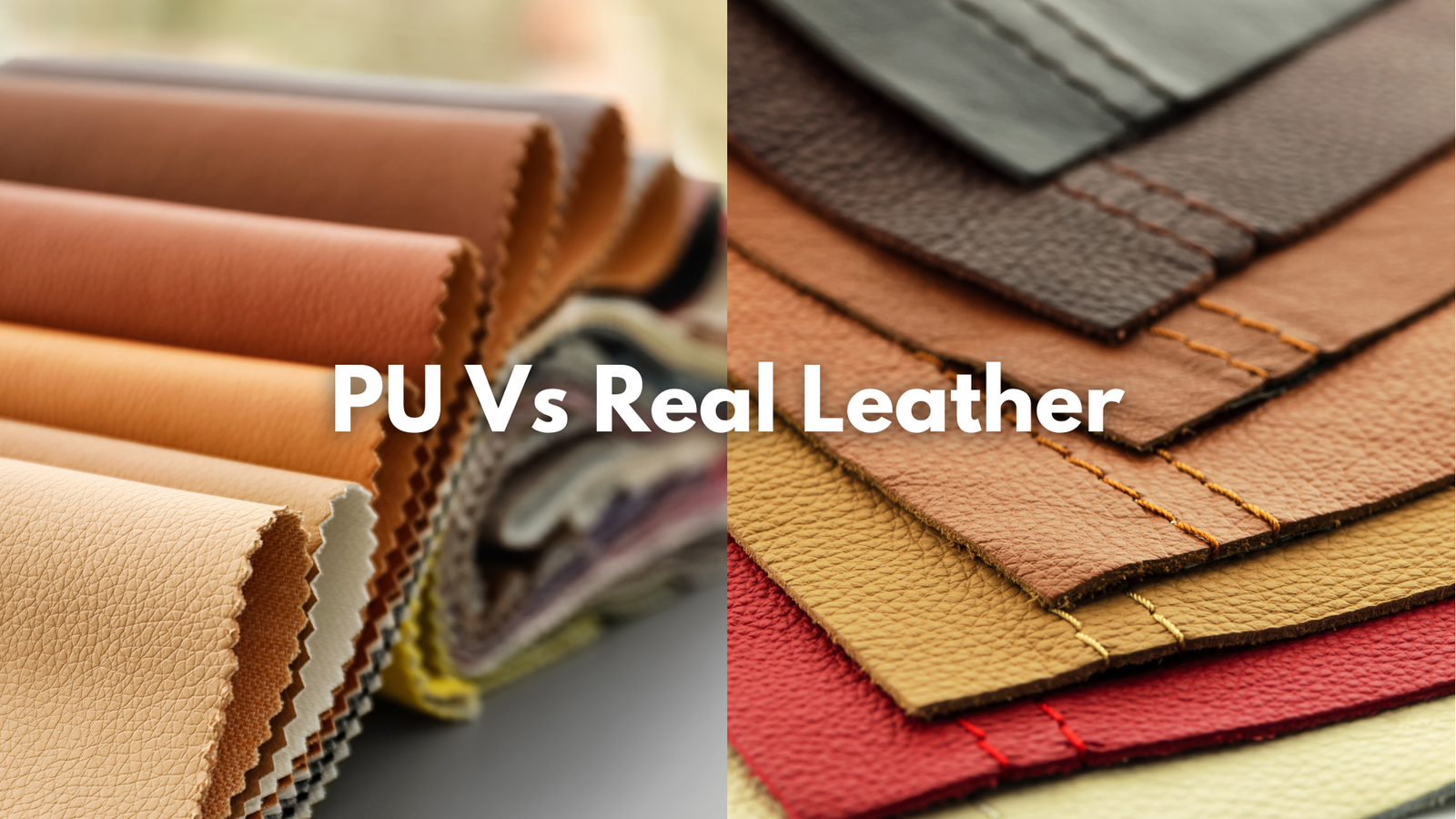You are probably deciding whether to buy a PU or real leather sofa based on environmental concerns such as carbon footprint. Let's start.
The carbon footprint of real leather and PU (polyurethane) leather differs due to the production processes involved, and each material has its environmental impacts.
Real Leather:
Real leather has a higher carbon footprint primarily because:
- Livestock farming for leather production generates significant amounts of greenhouse gases, including methane and nitrous oxide, especially from cows.
- Tanning and processing leather require chemical treatments that can harm the environment if not managed responsibly.
- The energy used in raising, feeding, and transporting livestock further adds to the overall carbon footprint.
However, real leather is biodegradable (if not heavily treated) and can last for decades, potentially offsetting its initial environmental impact.
PU Leather:
PU leather, although a synthetic material, typically has a lower initial carbon footprint compared to real leather because:
- It is made from petroleum-based products, and the production process, while energy-intensive, doesn't involve livestock farming.
- PU leather is made in factories using chemicals and synthetic processes, which can be less resource-intensive than raising animals.
On the downside, PU leather is not biodegradable and can take hundreds of years to decompose. Additionally, its production relies on fossil fuels, contributing to pollution and long-term environmental concerns.
Conclusion:
- Short-term carbon footprint: PU leather is generally lower.
- Long-term environmental impact: Real leather may have more durability and can break down naturally, while PU leather contributes to long-term plastic waste.
In summary, PU leather has a lower carbon footprint in the production phase, but real leather's longevity and biodegradability can make it more environmentally sustainable in the long run, depending on use and disposal.
Americana 3 Seater (MB0642) 1.91m Full Top Grain Leather Sofa
A Counter Argument
But livestock farming produces meat, a major benefit. This offsets most of the carbon footprint. Is this true?
Answer:
While livestock farming does produce meat as a major benefit, which adds value to the process, this doesn't fully offset the carbon footprint of leather production. Here’s why:
1. Meat and Leather Are Co-Products, Not By-Products:
- Leather is often considered a co-product of livestock farming, rather than just a by-product of meat production. This means the environmental impact of livestock farming, including methane emissions, deforestation, and resource use, is partially allocated to both meat and leather.
- While meat is the primary product, leather production still carries its share of the environmental burden, particularly when it comes to the energy, water, and chemicals used in tanning and processing.
2. Livestock's Environmental Impact is Significant:
- The livestock industry is one of the largest contributors to global greenhouse gas emissions, particularly methane, which is about 25 times more potent than CO₂. Even with meat as the primary output, the carbon footprint of raising animals remains substantial.
- According to the Food and Agriculture Organization (FAO), the livestock sector is responsible for 14.5% of global greenhouse gas emissions—a large portion that includes emissions from land use, feed production, and animal digestion, among other processes.
3. Leather Tanning Process Adds to the Footprint:
- Even after the animals are slaughtered, the tanning and leather processing phases add a significant carbon footprint, using large amounts of water, energy, and chemicals. These processes have their own environmental impact, separate from meat production.
4. Offsetting Only to an Extent:
- While it's true that producing meat is a major economic and nutritional benefit, it doesn’t eliminate the high environmental costs associated with livestock farming. Leather contributes value to the livestock industry but doesn’t reduce the greenhouse gases emitted during the animals’ life cycles.
5. Sustainability Measures:
- Sustainable livestock farming practices, like regenerative grazing or more efficient feed, can help reduce the carbon footprint of the industry overall. However, these efforts don’t entirely negate the environmental costs and carbon footprint associated with both meat and leather production.
Conclusion:
While the production of meat certainly adds value and offsets some of the environmental costs, livestock farming’s impact on climate change is still significant. Leather remains part of this environmental footprint, even if the primary purpose of raising livestock is for meat. Therefore, while meat production is an important factor, it does not entirely balance out the carbon footprint associated with leather production.

You Don't Have To Agree
But livestock farming and regenerative animal grazing helps the soil biology and prevents over tillage from crop growing. It helps reduce the overall carbon footprint of the livestock and leather industries.
Answer:
Livestock farming when paired with practices like regenerative grazing, can offer significant environmental benefits, especially in comparison to some crop farming methods that involve over-tillage. Here's how livestock farming, specifically regenerative grazing, can help improve soil health and contribute to a more sustainable agricultural system:
1. Soil Health Improvement:
- Regenerative grazing practices involve rotating livestock over different areas of land, mimicking natural grazing patterns seen in wild ecosystems. This method promotes healthier grasslands, as the livestock’s hooves help break up the soil, allowing water and nutrients to infiltrate more effectively.
- Animal manure acts as a natural fertilizer, enriching the soil with organic matter and nutrients. This, in turn, boosts microbial activity, enhances soil structure, and increases biodiversity, leading to more fertile and resilient soils.
2. Carbon Sequestration:
- One of the most significant benefits of regenerative grazing is its ability to sequester carbon. Well-managed grazing lands can capture and store carbon dioxide from the atmosphere in the soil, a process known as carbon sequestration.
- This can help mitigate climate change by reducing overall greenhouse gas levels in the atmosphere. Studies show that properly managed grazing systems can sequester more carbon than they emit, making livestock farming a potential climate solution when done sustainably.
- Regenerative grazing encourages plant growth, which leads to stronger root systems and healthier soil. Healthier soil can store more carbon, reducing the amount of carbon released into the atmosphere.
3. Prevention of Over-Tillage and Erosion:
- Continuous crop farming and tillage can lead to soil degradation, erosion, and a decline in soil fertility. Tilling disturbs the soil structure, releases carbon into the atmosphere, and can reduce water retention capacity.
- In contrast, regenerative grazing systems prevent these issues by reducing the need for monocrop farming, maintaining perennial grasses, and allowing the soil to regenerate naturally. This reduces soil erosion and helps the land retain moisture, which is crucial in preventing desertification.
4. Biodiversity Enhancement:
- Livestock grazing in a regenerative system encourages the growth of a variety of plant species. By avoiding overgrazing and practicing rotational grazing, native grasses, wildflowers, and other vegetation can thrive, creating a more diverse ecosystem.
- This biodiversity is not only good for soil health but also supports wildlife, insects, and pollinators, which are crucial for healthy ecosystems and sustainable food systems.
5. Reduced Dependence on Synthetic Inputs:
- Regenerative livestock systems reduce the need for synthetic fertilizers and pesticides because animals provide natural fertilization through manure and help control weeds by grazing on them.
- This further lowers the carbon footprint associated with industrial agriculture, which relies heavily on synthetic inputs that have a large environmental cost in terms of production and application.
6. Water Retention and Drought Resistance:
- Healthy, well-managed soils with abundant organic matter can retain water more effectively, reducing runoff and erosion. This improves the resilience of farmland to drought conditions, as soil can hold more moisture for longer periods.
- Regenerative grazing helps build this kind of soil, making the land more resilient to extreme weather patterns linked to climate change.
Balancing Livestock Farming with Environmental Concerns:
- While regenerative grazing offers substantial benefits for soil health and carbon sequestration, livestock farming as a whole—particularly intensive, industrial-scale operations—still has significant environmental impacts, including methane emissions from ruminants like cattle.
- The environmental benefits from regenerative practices are contingent on how the land is managed. Overgrazing, for example, can degrade land and lead to desertification, while poor livestock management can lead to water contamination and increased deforestation.

Conclusion:
Regenerative grazing and sustainable livestock farming can play a crucial role in building soil health, sequestering carbon, and reducing environmental damage from industrial agriculture. These practices offer a positive counterpoint to the environmental concerns typically associated with livestock farming, such as methane emissions. However, it’s important to balance this with responsible livestock management and to continue reducing the overall carbon footprint of animal agriculture.
While real leather from sustainably managed livestock farms may have a reduced carbon footprint compared to more industrialized leather production, it still carries environmental costs. In comparison, PU leather, though synthetic and made from fossil fuels, avoids these livestock-related concerns but contributes to plastic pollution and is not biodegradable. Ultimately, both materials have their trade-offs, and the best choice depends on the specific environmental and ethical priorities of the consumer.
Recommended Links
- Shop all KUKA leather sofas.
- Recliner Collection.
- Caring for PU, PVC, and faux leather sofas and furniture.
- Semi-Aniline Leather vs. Full-Aniline Leather: Understanding the Difference.
- Leather Sofas - Top 10 Frequently Asked Questions (Singapore).
- Shop solid wood sofas.
- Shop leather recliners.
- Follow our facebook page for the latest deals.















